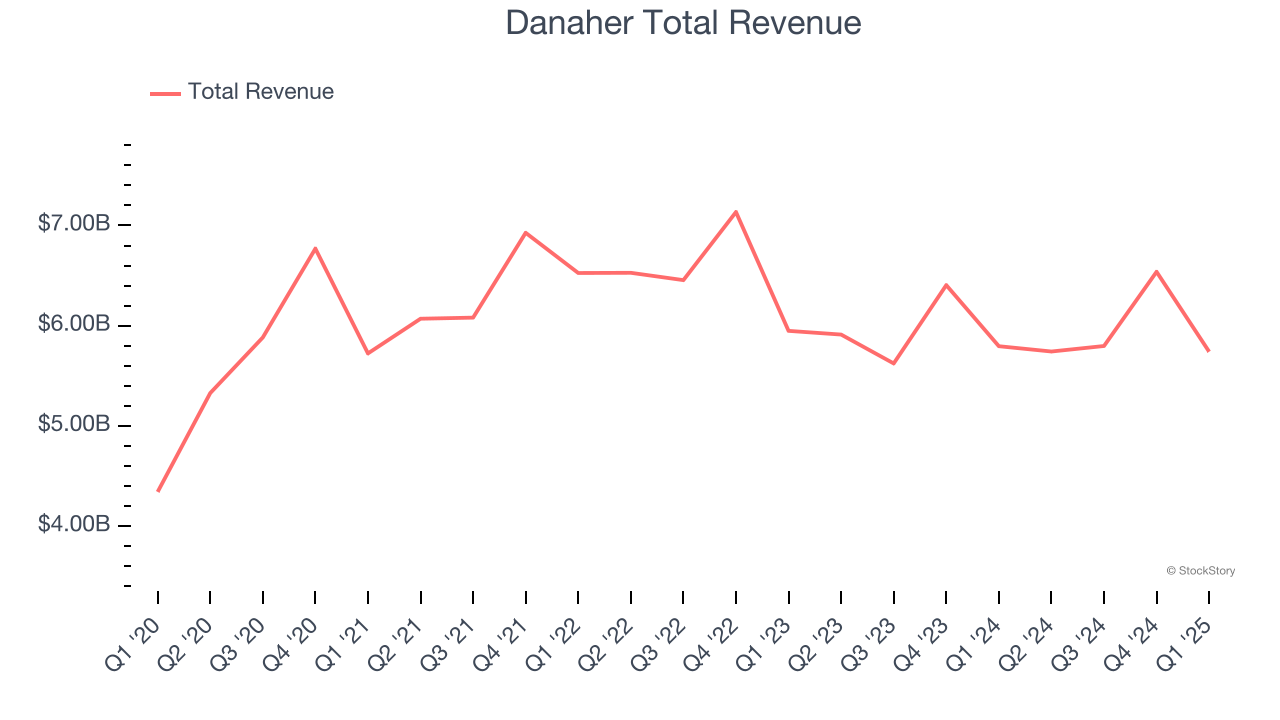
As the Q1 earnings season comes to a close, it’s time to take stock of this quarter’s best and worst performers in the research tools & consumables industry, including Agilent (NYSE:A) and its peers.
The life sciences subsector specializing in research tools and consumables enables scientific discoveries across academia, biotechnology, and pharmaceuticals. These firms supply a wide range of essential laboratory products, ensuring a recurring revenue stream through repeat purchases and replenishment. Their business models benefit from strong customer loyalty, a diversified product portfolio, and exposure to both the research and clinical markets. However, challenges include high R&D investment to maintain technological leadership, pricing pressures from budget-conscious institutions, and vulnerability to fluctuations in research funding cycles. Looking ahead, this subsector stands to benefit from tailwinds such as growing demand for tools supporting emerging fields like synthetic biology and personalized medicine. There is also a rise in automation and AI-driven solutions in laboratories that could create new opportunities to sell tools and consumables. Nevertheless, headwinds exist. These companies tend to be at the mercy of supply chain disruptions and sensitivity to macroeconomic conditions that impact funding for research initiatives.
The 10 research tools & consumables stocks we track reported a mixed Q1. As a group, revenues beat analysts’ consensus estimates by 1.5% while next quarter’s revenue guidance was 0.6% above.
In light of this news, share prices of the companies have held steady. On average, they are relatively unchanged since the latest earnings results.
Agilent (NYSE:A)
Originally spun off from Hewlett-Packard in 1999 as its measurement and analytical division, Agilent Technologies (NYSE:A) provides analytical instruments, software, services, and consumables for laboratory workflows in life sciences, diagnostics, and applied chemical markets.
Agilent reported revenues of $1.67 billion, up 6% year on year. This print exceeded analysts’ expectations by 2.7%. Despite the top-line beat, it was still a mixed quarter for the company with a solid beat of analysts’ organic revenue estimates.

Agilent delivered the weakest full-year guidance update of the whole group. Interestingly, the stock is up 7.3% since reporting and currently trades at $119.02.
Is now the time to buy Agilent? Access our full analysis of the earnings results here, it’s free.
Best Q1: Danaher (NYSE:DHR)
Born from a real estate investment trust that transformed into a manufacturing powerhouse, Danaher (NYSE:DHR) is a global science and technology company that provides specialized equipment, software, and services for biotechnology, life sciences, and diagnostics.
Danaher reported revenues of $5.74 billion, flat year on year, outperforming analysts’ expectations by 2.7%. The business had a very strong quarter with a solid beat of analysts’ organic revenue and EPS estimates.

The market seems happy with the results as the stock is up 8.4% since reporting. It currently trades at $200.30.
Is now the time to buy Danaher? Access our full analysis of the earnings results here, it’s free.
Weakest Q1: Avantor (NYSE:AVTR)
With roots dating back to 1904 and embedded in virtually every stage of scientific research and production, Avantor (NYSE:AVTR) provides mission-critical products, materials, and services to customers in biopharma, healthcare, education, and advanced technology industries.
Avantor reported revenues of $1.58 billion, down 5.9% year on year, falling short of analysts’ expectations by 1.6%. It was a softer quarter as it posted a miss of analysts’ organic revenue and EPS estimates.
Avantor delivered the weakest performance against analyst estimates and slowest revenue growth in the group. As expected, the stock is down 14% since the results and currently trades at $13.30.
Read our full analysis of Avantor’s results here.
Bruker (NASDAQ:BRKR)
With roots dating back to the pioneering days of nuclear magnetic resonance technology, Bruker (NASDAQ:BRKR) develops and manufactures high-performance scientific instruments that enable researchers and industrial analysts to explore materials at microscopic, molecular, and cellular levels.
Bruker reported revenues of $801.4 million, up 11% year on year. This print beat analysts’ expectations by 4.3%. Zooming out, it was a satisfactory quarter as it also logged an impressive beat of analysts’ organic revenue estimates but a significant miss of analysts’ full-year EPS guidance estimates.
Bruker scored the biggest analyst estimates beat, fastest revenue growth, and highest full-year guidance raise among its peers. The stock is down 3.4% since reporting and currently trades at $38.10.
Read our full, actionable report on Bruker here, it’s free.
Mettler-Toledo (NYSE:MTD)
With roots dating back to the precision balance innovations of Swiss engineer Erhard Mettler, Mettler-Toledo (NYSE:MTD) manufactures precision weighing instruments, analytical equipment, and product inspection systems used in laboratories, industrial settings, and food retail.
Mettler-Toledo reported revenues of $883.7 million, down 4.6% year on year. This result topped analysts’ expectations by 1%. Aside from that, it was a slower quarter as it produced a miss of analysts’ full-year EPS guidance estimates.
The stock is up 12.1% since reporting and currently trades at $1,183.
Read our full, actionable report on Mettler-Toledo here, it’s free.
Market Update
As a result of the Fed’s rate hikes in 2022 and 2023, inflation has come down from frothy levels post-pandemic. The general rise in the price of goods and services is trending towards the Fed’s 2% goal as of late, which is good news. The higher rates that fought inflation also didn't slow economic activity enough to catalyze a recession. So far, soft landing. This, combined with recent rate cuts (half a percent in September 2024 and a quarter percent in November 2024) have led to strong stock market performance in 2024. The icing on the cake for 2024 returns was Donald Trump’s victory in the U.S. Presidential Election in early November, sending major indices to all-time highs in the week following the election. Still, debates around the health of the economy and the impact of potential tariffs and corporate tax cuts remain, leaving much uncertainty around 2025.
Want to invest in winners with rock-solid fundamentals? Check out our 9 Best Market-Beating Stocks and add them to your watchlist. These companies are poised for growth regardless of the political or macroeconomic climate.
